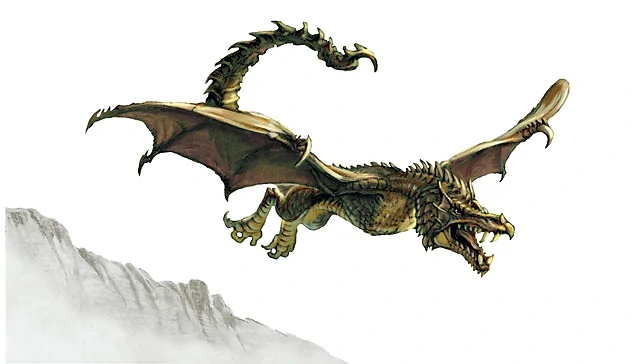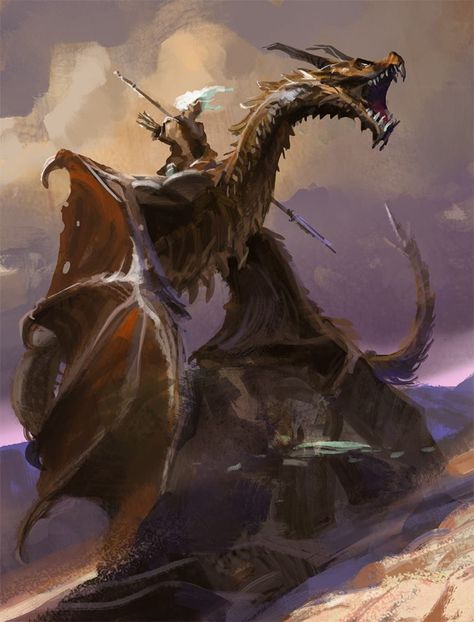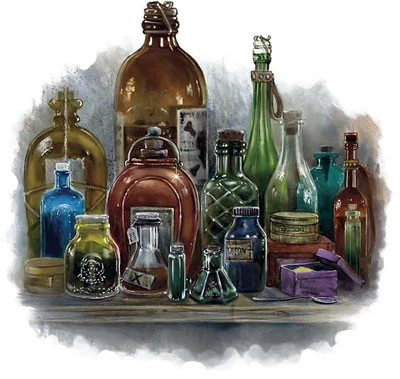I remember the first time I threw a Wyvern at my DnD players. They got very excited, thinking it was a small dragon since they’d not encountered any dragons in DnD yet.
After successfully killing the Wyvern with no major injuries, their self congratulations were dampened when I commented that this was a Wyvern, which are, as I like to call them, the chickens of the dragon family.
Wyverns are vicious yet dumb, but they can be a deadly encounter for players. This Wyverns 5e guide covers the essentials for running Wyverns as a DM, how to run them in combat, and extra tips on incorporating Wyverns into your world so that players won’t mistake them for baby dragons.
Wyverns 5e Guide: The essentials
Wyverns are the perfect mini dragon to throw at players not quite ready for a dragon yet. These winged lizards are ‘distant cousins’ of dragons and, with a challenge rating of 6, can be introduced when a small party hits level 5 or a large party hits level 4.
Wyverns can fly, make two attacks, and have a pretty nasty poisonous stinger. Player characters at level 4 or 5 will definitely find Wyverns tough and maybe even deadly, but Wyverns have two attributes that DMs and players should remember: they are hunting for food and they are very stupid.
What are Wyverns?

As mentioned above, Wyverns look a lot like small dragons, and they are distantly related. These monsters have two legs (unlike dragons, which have four), wings, scales, sharp teeth and claws, and poisonous stingers, making their tails look like scorpion tails. I earnestly believe this is what would happen if a dragon and a chicken had a baby.
Wyverns are much smaller than dragons, but they are not small. They can be between 12 and 30 ft in length, making these Large creatures as per DnD size rules. Their wingspan could grow up to 50 ft.
Wyverns are covered in brown, gray, ruddy red, or muddy green scales — no glistening gold, deep green, or scarlet red here. Their coloring, I think, should match their environment. After all, Wyverns are hunters first and foremost. So Wyverns living in mountain ranges might have stony gray scales while forest-dwelling Wyverns might have brown or green scales.
Wyverns: A DM’s guide
Wyvern Actions
As per the Monster Manual, Wyverns make two attacks. Typically, this is one attack with its Bite and one with its Stinger. This changes, however, if the Wyvern is flying, in which case it can use its Claws instead of one of the other attacks. All three attacks are melee attacks:
Bite: To hit: +7
Reach: 10ft
Targets: 1
Damage: 11 (2d6 + 4) piercing damage
Stinger: To hit: +7
Reach: 10ft
Targets: 1
Damage: 11 (2d6 + 4) piercing damage
Poison: Target makes a DC 15 Constitution saving throw. On a fail, take 24 (7d6) poison damage or half that on a successful save.
Claws: To hit: +7
Reach: 5ft
Targets: 1
Damage: 13 (2d8 + 4) slashing damage
Wyvern Attributes

The Monster Manual also provides the following statistics and attributes for Wyverns in 5e:
- Armor Class: 13 (Natural Armor)
- Hit Points: 110 (13d10+39)
- Speed: 20ft, 80ft (flying)
- Challenge: 6
- XP: 2300
- Perception: +4
- Stat Block: STR – 19 (+4); DEX – 10; CON – 16 (+3); INT – 5 (-3); WIS – 12 (+1); CHA – 6 (-2)
Wyverns in Combat
Wyverns are fairly simple to run in combat. They don’t have any special abilities other than their poisonous stinger.
Despite their simplicity, Wyverns don’t need to be boring in combat. They may not be the brightest creatures, but they are keen hunters and have the advantage of flight on their side.
Here are some tips for running Wyverns in combat based on both information about them in the Monster Manual and my own experience running Wyverns:
- Flight: The Monster Manual describes Wyverns as “aerial hunters,” so as a DM, you want to make sure these overgrown chickens are making good use of one of their few advantages over actual chickens — they can fly. Wyverns should only touch the ground if they have no other choice, such as if players encounter them in a low-lying cave.
- Hungry hunters: Food and defense are the Wyvern’s main motivations. While Wyverns aren’t the smartest creatures, they will use hunter tactics, such as stalking prey, and won’t enter a fight they are certain to lose. And if an easier meal appears, they’ll choose that over a tough fight. Finally, Wyverns will probably aim for the weakest party members, especially small party members, like gnomes or halflings, who could even be grasped in a Wyvern’s claws and flown away to its lair.
- Easily tricked: That minus three on Intelligence is worth remembering. It doesn’t take much to distract or trick a Wyvern. Wyverns also aren’t smart enough to be tactical in battles where enemies have unusual weapons or spells.
Using Wyverns in your DnD campaign

Wyverns are a fun monster to throw at players who are exploring caves, mountains, or forests.
Taming Wyverns:
Wyverns can be tamed and used as mounts, but it’s not easy. These are essentially wild beasts with violent tendencies and even years of training with a master could still end with that master being killed by his pet.
Alternatively, Wyverns could be raised by humans from birth (simple enough if players can get hold of a Wyvern egg, but their innate wildness will still appear without careful training.
Wyvern Hide:
A dead Wyvern can yield many useful things to a player, including a strong but lightweight hide. This can be used for many things, including bookbinding and armor.
In my game, players can take Wyvern Hide to an armorer to make Wyvern Leather Armor, which offers an AC of 14 plus the wearer’s DEX modifier and a +5 to the wearer’s saves versus poison.
Wyvern Poison:

Players can also harvest poison from a dead Wyvern, which has the same effect as it does when a Wyvern uses their stinger. I tend to rule that a player could harvest enough poison from a dead Wyvern to coat 20 arrows or coat the tip of a blade 20 times.
Other Wyvern parts:
Wyvern bones and blood can be sold and, if taken to an alchemist, could be used to make poisons. Wyvern meat is also edible and, you guessed it, tastes like chicken.
Wyvern Storyline Ideas
While Wyverns work well as chance encounters in forests, caves, and mountainous areas, they can also be incorporated more meaningfully into your homebrew campaign. There is plenty of opportunity for unwitting villagers to send players after a ‘dragon’ that’s been eating livestock that turns out to be a Wyvern. Here are some more unique ideas:
In Pursuit of Poison
When traveling through a small town, you meet a local wizard in need of your assistance. He is crafting poison for the local militia (or so he says) and wants to experiment with Wyvern poison. He knows they live in the nearby forest, so asks the players to bring him a Wyvern stinger for his experiments.
This simple quest can kick off more storylines. Why do the local militia need such strong poison for their arrows? Is that what the wizard is really using the poison for? What if there is a rival wizard in the forest who keeps the Wyverns as beloved pets?
The Princess’s Pet

The Princess was gifted a Wyvern egg for her fifth birthday. It hatched, and she raised it with love and care. Many in the palace came to know the Wyvern, named Fluffy, as a sweet albeit stupid creature with a love for salted fish and belly scratches.
But something has gone wrong. The Princess was brought in with her face scarred and her tongue ripped out. The King, always suspicious of the Wyvern as a pet, blames Fluffy and has sent the palace guard into the woods to capture and execute it.
The players, however, will receive a letter from the Princess, begging them to find Fluffy before the guards do. She says Fluffy was protecting her from a Manticore, which attacked her in the forest. If the group can find the Manticore and protect Fluffy from the palace guard, they may be able to clear his name.
Frequently Asked Questions
Question: Can you tame a Wyvern in DnD?
Answer: Yes. Wyverns can be tamed but not easily, as they have an intrinsically wild and violent nature. You can also raise Wyverns from birth if you can get hold of a Wyvern egg, which might make them easier to tame.
Question: Can Wyverns be used as a mount?
Answer: Yes. A tamed Wyvern can be used as a mount, but it is risky as even a tamed Wyvern may still attack its master or others.
Question: Can Wyverns speak in DnD?
Answer: No — Wyverns cannot speak. The Monster Manual does not provide a language for Wyverns, and generally they make animal noises such as hisses and growls. Some DMs, however, might rule that Wyverns can speak Draconic.
Question: How big is a Wyvern in DnD?
Answer: A Wyvern is a Large creature. It can grow between 12 and 30ft in length, and its wingspan can be up to 50ft wide.
Question: Are Dragons more powerful than Wyverns?
Answer: Yes, Dragons are much more powerful than Wyverns. A Wyvern has a challenge rating of 6 and no special powers beyond its poisonous stinger. A White Adult Dragon, the weakest of the adult dragons, has a challenge rating of 13.
Conclusion
Wyverns may not be dragons in the full sense of the word, but that doesn’t make them easy pickings for early-level player characters.
These vicious hunters can easily take out a low-level party, so don’t let their low intelligence fool you. That said, they can be tricked, and that poison can come in handy.
Wyverns make a fun addition to any DnD campaign. Whether they swoop down on unsuspecting players in a forest or players are tasked with killing one that’s been feeding off a village’s livestock, these can be a challenging encounter for players between levels 4 and 8.
- Best Alternatives to Dungeons & Dragons - August 23, 2023
- Wyverns 5e Guide: The Chickens of the Dragon Family - September 5, 2022
- Best DnD Dice Tray Ideas for Players and DMs - August 22, 2022

